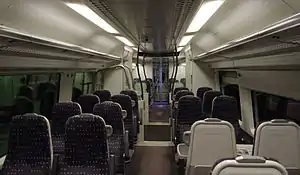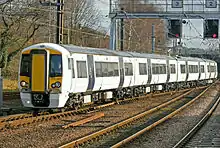British Rail Class 379
The British Rail Class 379 Electrostar is an electric multiple-unit (EMU) passenger train designed and built by the rolling-stock manufacturer Bombardier Transportation. The trains are part of the company's extensive Electrostar family.
| British Rail Class 379 Electrostar | |
|---|---|
.jpg.webp) Greater Anglia 379011 at Bethnal Green in 2012 | |
 The standard class interior of a Class 379. | |
| In service | 17 March 2011 – present |
| Manufacturer | Bombardier Transportation |
| Family name | Electrostar |
| Replaced | |
| Constructed | 2010–2011 |
| Number built | 30 trainsets |
| Formation | 4 cars per trainset |
| Fleet numbers | 379001 – 379030 |
| Capacity | 209 (189 Standard, 20 First)[1] |
| Operator(s) | Greater Anglia |
| Line(s) served | West Anglia Main Line |
| Specifications | |
| Maximum speed | 100 mph (161 km/h)[2] |
| Traction system | IGBT-VVVF (Bombardier MITRAC DR1000) |
| Electric system(s) | 25 kV 50 Hz AC Overhead |
| Current collection method | Pantograph |
| Track gauge | 1,435 mm (4 ft 8 1⁄2 in) standard gauge |
The Class 379 was specifically procured in response to a government white paper issued in 2007, under which £185 million of investment was issued to the West Anglia Main Line (WAML), the bulk of which was spent with Bombardier Transportation to procure the 34-strong Class 379 fleet of EMUs.[3] While the type was largely intended to increase capacity, its introduction did enable the withdrawal of ageing units such as the Class 317 EMUs; the programme also involved various infrastructure improvements. The Class 379's introduction was relatively smooth and brought about a noticeable step up in service quality.[3]
Since their introduction during early 2011, the Class 379 has become the principle type operated on the Stansted Express service; it has also been tasked with additional services between London Liverpool Street to Stansted Airport, Cambridge and Kings Lynn.[4] The fleet was initially operated by National Express East Anglia (NXEA)[5][6] and subsequently by Greater Anglia. During September 2016, it was announced that Greater Anglia was procuring a new fleet of Class 745/1 to replace all of its Class 379s by the end of 2019. Thus, the fleet shall likely be cascaded onto other operators.
Background
Around the start of the twenty-first century, the West Anglia Main Line (WAML) was relatively neglected in terms of investment and attention amongst railway planners in comparison to routes such as the Great Eastern Main Line (GEML) and the lines serving Tilbury and Southend. According to industry periodical RAIL, these lines had received considerably more infrastructure investment as well as new rolling stock that had enabled both non-stop services and a higher top speed of 100 mph (161 km/h), the WAML was largely worked by a two decade-old fleet of Class 317 electric multiple units (EMU) on infrastructure that restricted speeds to 80 mph (129 km/h) and only provided sufficient capacity for stopping services.[3] However, measures to improve the line were unveiled in a government white paper released during 2007; specifically, operator National Express was to received £185 million of investment in exchange for the introduction of various changes on the WAML, including improved facilities and new timetables; while cascaded trains for other lines would be brought in to bolster service levels in the short term, there was also a long term ambition to procure a newly-built fleet of trains to service the line.[3]
Accordingly, an order valued at £155 million was placed with rolling stock manufacturer Bombardier Transportation for 34 EMUs, these were subsequently designated as the Class 379.[3] The new fleet was procured with the intent to supplement, rather than replace, the majority of the line's existing rolling stock, and thus represented a significant increase in capacity on the WAML. The Class 379 had been ordered as a part of the wider NXEA Service Improvement Plan, which was enacted to expand capacity on the heavily crowded lines into London Liverpool Street.[7] Originally, the fleet was to be owned by Macquarie European Rail, however, as a consequence of Akiem's acquisition of Macquarie's assets, the Class 379 came into Akiem's ownership immediately upon their induction.[8] A key service that the type was procured for was the Stansted Express, from which National Express was reportedly deriving roughly 20 percent of its revenue from operating.[3]
All members of the class were manufactured at Bombardier Transportation Derby Litchurch Lane Works; the first unit was formally unveiled on 13 October 2010.[9] Testing of this initial unit commenced shortly thereafter, after which it was returned to Derby to receive its final fittings.[3] Deliveries of the fleet were at a consistent pace through to the final Class 379 being handed over during August 2011.[3]
Design and features

The Class 379 electric multiple unit is a member of Bombardier Transportation Electrostar family, although a number of its features are derived from the newer Aventra family instead.[9] Unlike some of the older rolling stock that it has displaced, it is equipped to perform regenerative braking to achieve a reduction in its energy consumption.[9] To increase serviceability and support the maintenance process, the Class 379 has been outfitted with Bombardier Transportation Orbita predictive fault monitoring system.[2] Other tweaks to improve service rates include the presence of CCTV cameras on the roof of the train to monitor the condition of the pantograph.[7] The type has been described as possessing relatively favourable ride quality, remaining smooth despite its high rate of acceleration.[3]
The Class 379 features a 2+2 seating arrangement for standard class, while more spacious 2+1 seating is installed in first class, providing 189 standard class seats and 20 first class seats across a typical consist.[1] The standard class seats are largely airline style, accompanied by a number of table seats; each airline seat feature a flip-down table, coat hook, and a single electrical socket. A total of two toilets are also present on the typical four-coach consist, one of which is enlarged to accommodate baby-changing facilities and use by the disabled.[3] To assist in its use by airport-bound passengers, relatively large luggage racks have been installed at several locations, in addition to the smaller overhead luggage racks.[2] A considerable number of bins are present, intended to reduce littering and aid the cleanup process.[3]
Amongst the various passenger amenities present, all carriages are outfitted with Wi-Fi, the apparatus for which being supplied by the Swedish company Icomera.[7] This connectivity is used for multiple purposes beyond the personal internet use of the passengers; various onboard systems, including the reservation, CCTV, passenger information displays, and miscellaneous sensors and monitoring systems, are interconnected via the Wi-Fi. Condition-related data is seamlessly fed back to the operator's control centre, aiding operations and maintenance alike.[7] A digital announcement system is also present, which sounds only during the departure of, or upon the approach to, a served station.[3] The interior lighting was supplied by Teknoware, including the state-of-the-art emergency lighting that fulfils GM/RT 2130 requirements.[7] Air conditioning is also present to enhance passenger comfort levels.[3]
Operations


During early 2011, the Class 379 commenced its phased introduction into revenue service. On 17 March 2011, the first two units, 379005 and 379006, performed the type's first service amid a high-profile launch officiated by Secretary of State for Transport Philip Hammond.[10] 379005 was named Stansted Express during a ceremony held at London Liverpool Street. Over the following three months, a further 18 sets joined the initial pair working the Stansted Express services. They have been worked in a mixture of 12-car and 8-car lengths.[10] The type's introduction was relatively trouble-free, with only minor issues such as moving the onboard catering trollies without damaging the interior being quickly resolved.[3]
During Summer 2011, the remaining ten Class 379s began entering service on Cambridge services. By mid-August 2011, all of the units had entered service; this milestone had been achieved two months ahead of schedule and enabled the airport services to be entirely worked by eight-car Class 379s, while the older Class 313s were cascaded away onto other routes.[3] The December 2011 timetable change included the introduction of 12-car trains on some peak workings out of Liverpool Street to/from Bishops Stortford, Harlow Town, Ely, Kings Lynn and Cambridge. Plus on some services out of Stratford to/from Cambridge, Harlow Town and Bishops Stortford and on some Bishops Stortford/Stansted Airport-Cambridge services. They work on long distance express services.[11]
The fleet has been maintained by Bombardier Transportation at Ilford EMU Depot.[5]
Following the end of National Express East Anglia franchise, the Class 379s have been operated by Greater Anglia. During September 2016, it was announced that Greater Anglia were in the process of procuring a new fleet of Stadler FLIRT EMUs, designated Class 745/1 operated as fixed-formation 12-car trains. These were intended to replace all of the operator's Class 379s by the end of 2019.[12][13] However, the new fleet's introduction was delayed, the first Class 745/1 entered service on 28 July 2020.[14][15]
Battery-Electric Multiple Unit trial
During 2013, the national infrastructure owning company Network Rail announced that unit 379013 would be used as a testbed for a future Battery-Electric Multiple Unit.[16][17] Following several months of conversion work and non-service testing, the unit was used to carry passengers for the first time on a Manningtree–Harwich Town service on 12 January 2015. Throughout its five week trial period, data was gathered to assess its performance; it could reportedly operate for up to an hour on battery power alone, while charging via the pantograph took two hours.[18]
Fleet details
| Class | Operator | No. Built | Year Built | Cars per Set | Unit nos. |
|---|---|---|---|---|---|
| Class 379 | Greater Anglia | 30 | 2010–2011 | 4 | 379001 – 379030 |

References
- "East Anglia 2016 Franchise Agreement" (PDF). gov.uk. 2016. p. 176.
- "Stansted Airport trains under construction". Railway Gazette International. London. 21 July 2010. Archived from the original on 16 June 2011. Retrieved 23 July 2010.
- "Stansted stock stands up to the test". railmagazine.com. 27 July 2011.
- Rail. 673. Peterborough. 29 June 2011. p. 37. Missing or empty
|title=(help) - "Bombardier signs Stansted airport train order". Railway Gazette International. London. 2 April 2009. Retrieved 9 August 2010.
- Today's Railways UK, issue 91.
- "Class 379 set to woo Stansted passengers". Modern Railways. London. December 2010. pp. 56–60.
- "Akiem acquires Macquarie Rail – the new combined locomotive fleet". railcolornews.com. 23 April 2020.
- "First new Stansted Express train rolls out". Railway Gazette International. London. 14 October 2010.
- "National Express launches Class 379s on Stansted Express service" (PDF). Railway Herald (260). Scunthorpe. 21 March 2011. p. 3. Archived from the original (PDF) on 7 October 2011. Retrieved 8 May 2011.
- "New timetable for the West Anglia network". National Express East Anglia. Retrieved 11 November 2011.
- Modern Railways Magazine, September 2016. issue ?, pp. 13-15.
- Clinnick, Richard (7 June 2019). "Contingency plans in place for Greater Anglia's main line fleet". railmagazine.com.
- Holden, Michael (28 July 2020). "Brand new Stansted Express trains enter service in London". RailAdvent.
- "Stansted Express Class 745/1 trainsets enter passenger service". Railway Gazette International. 28 July 2020.
- "We're developing a prototype battery powered train". Network Rail. Archived from the original on 30 August 2013. Retrieved 19 August 2013.
- "On-track trials of prototype battery-powered train begin". Network Rail. 12 August 2014. Archived from the original on 16 September 2014. Retrieved 28 September 2014.
- Clinnick, Richard (13 January 2015). "Battery-powered Electrostar enters traffic". railmagazine.com. Bauer Consumer Media.
External links
![]() Media related to British Rail Class 379 at Wikimedia Commons
Media related to British Rail Class 379 at Wikimedia Commons